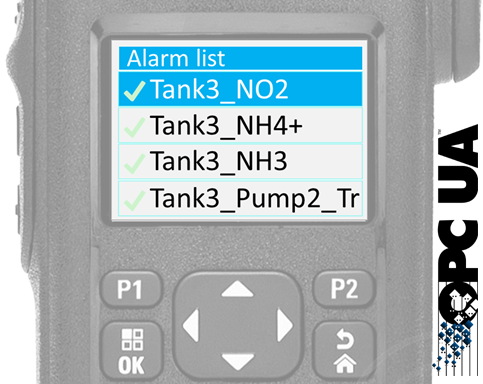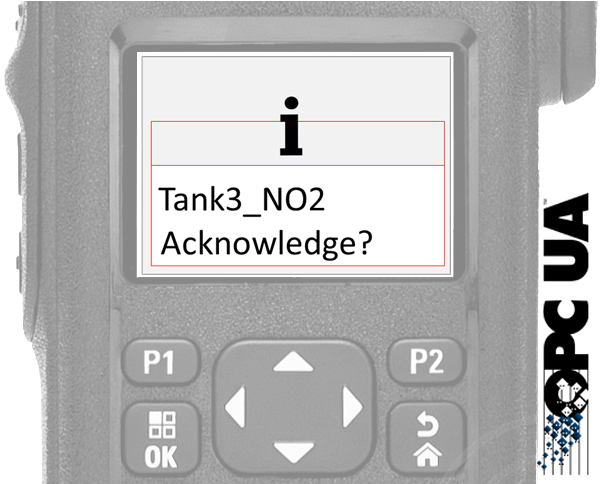
User Manual
This Alarm Dispatch for Radios User Manual will support during the configuration of the different aarm sources, the creation of the radio groups & finally the set-up of the automatic alarm dispatch rules.
Alarm Dispatch for Radios
The Alarm Dispatch for Radios is purely software based. Its three software components are (1) the radio alarm list, (2) the OPC AlarmClient & (3) the web-panel where to configure the radios, the servers and the alarm dispatching rules. The application is Windows Based. Administrator rights will be required during the installation phase to install the application and configure the network connectivity with the radios.
Topology - Alarm Dispatch for Radios: WebPanel (1), OPC Alarm Client (2), Ethernet card to acess the process network (3), USB port to connect to the mobile radio (4), Portable Radio subscribers displaying the alarm list (5), Several Alarm Sources on the process network (6).
Hardware requirements
Although the application is purely software, a mobile radio (for instance DM4400 series by Motorola Solutions) is required to broadcast the alarm messages within the Mototrbo Digital Radio infrastructure. This point of entry does not require any access to the repeater. The interface between the Alarm Client computer and the mobile radio is a USB/DB9 cable (to options front/back are listed below).
List of hardware components:
Alarm Client computer (Windows XP, seven, 10, 32 or 64 bit architecture, min 2GB RAM) - NOT INCLUDED
DM400e, part number MDM28JNC9VA2AN - NOT INCLUDED
front connector, use part number HKN6184C or back connector use part number PMKN4010B - INCLUDED
General Option board (PMLN7324AS) - NOT INCLUDED on non ATEX portable radios (OPTIONAL)
Radio Alarm List
The portable radio displays the active alarm list. It gives the operator the most updated view of the alarm list. Alarms can be acknowledged successively sending an acknowledgment message to the its Alarm Sources (OPC Alarm Servers). The Motorola Radio acts as an OPC Alarm Client connecting to ONE or SEVERAL alarm sources.
OPC ALARM CLIENT
One strong feature of the Alarm Dispatch for Radios is the capability to aggregate alarms from different sources available on the process network. Regardless of the Programmable Logical Controller (PLC) or the control system, the Radios will display alarms from vraious sources. Alarm Servers are defined in the webpanel running on the OPC Alarm Client computer. This computer is a vital component of the architecture as it acts as a gateway between the alarm servers and the Mototrbo digital radio network.
Dispatcher webpanel
The webpanel configuration is straight forward. It requies to configure the radios (2) to receive the alarm messages, subcribe to the alarms (3) that should be dispatched, identify the different alarm sources (4), configure operators into Groups in order to dispatch the alarms to a group instead of an individual radio, adjust the dispatching rules (6) and save the configuration (1).
Save
Subscribers (radios)
Alarms
Network
Groups
Dispatch
A visual representation of the webpanel HMI is described (below).
Portable Radio installation
The portable radio should be equipped with the General Option Board (GOB - part PMLN7324AS) developped by Motorola Solutions. For ATEX radios, the GOB is pre-installed by default, whereas non-ATEX radios require to open the radio to install the option board. This procedure is described in the Radio Owner's Manual by Motorola Solutions.
Once the GOB is installed and activated in the CPS radio configuration, a firmware update will be required to access the Alarm Dispatch functions. The latest GOB Flash Tool R150301- is available for download.
OPC ALARM CLIENT installation
The OPC Alarm Client is responsible to access the process & control network and read the active alarms from different locations on the network. The ALARM CLIENT computer should therefore be installed within the firewall with a physical access the process network. Alternative remote solutions are available making use of a Virtual Private Network - VPN adaptor to access the process network. For more information, please contact us on our support email support@datamatik.no
The ALARM CLIENT computer should also be connected to a mobile radio if not to the repeater itself to access the Mototrbo infrastructure.







